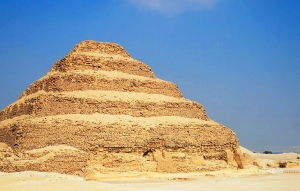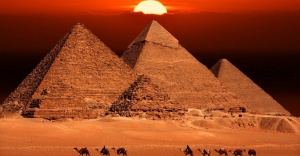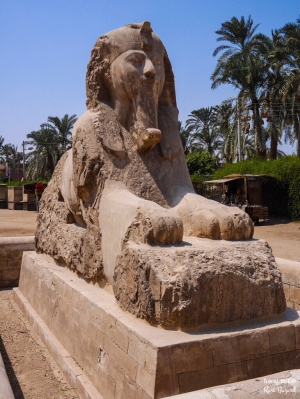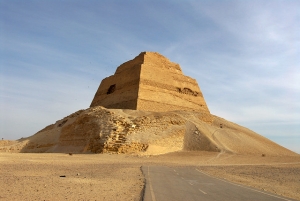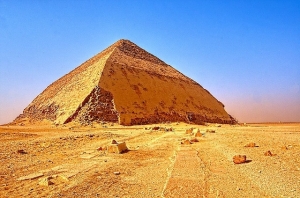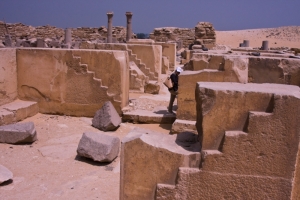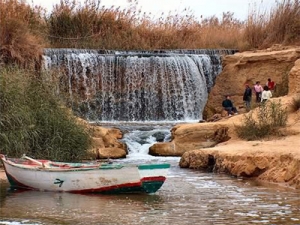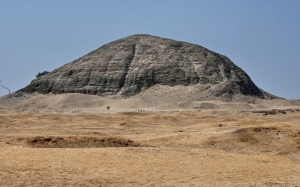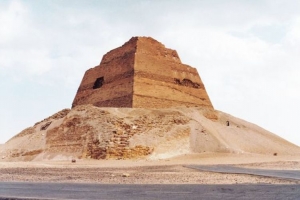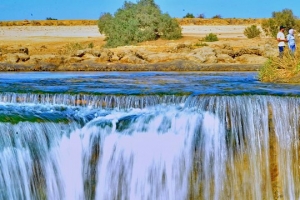+2 0122-345-3028
This email address is being protected from spambots. You need JavaScript enabled to view it.
Super User
Saqqara
Saqqara
Sakkara is one section of the great necropolis of Memphis, the Old Kingdom capital and the kings of the 1st Dynasty as well as that of the 2nd Dynasty. are mostly buried in this section of the Memphis necropolis. It has been of constant interest to Egyptologists.
5th Dynasty kings such as Userkaf (pyramid) and Djedkare-Izezi built their pyramids at Sakkara. The last king of 5th Dynasty, Unas, decorated his burial chamber with the famous 'Pyramid Texts', spells written to help the king ascend to the heavens and descend again, which reveal the relationship of the king to the gods. 6th Dynasty kings such as Pepi I, Merenre and Pepi II built their pyramids to the south of Sakkara.
Sakkara is also famous for its private Old Kingdom tombs, which contain beautiful and revealing scenes men force- feeding geese, cattle crossing a canal, men dragging a statue on a sled to the tomb. The best-known tombs are those of Ti, Kagemni, the 'Two Brothers', and Ptahhotep; the most famous is that of Meruruka.
The Step Pyramid of Djoser (Zoser)
Sakkara is best known for the Step Pyramid, the oldest known of Egypt's 97 pyramids. It was built for King Djoser of the 3rd Dynasty by the architect and genius Imhotep, who designed it and its surrounding complex to be as grand as it was unique and revolutionary. Imhotep was the first to build stone tombs in honor of the king's majesty..
On the Pyramid, most of the outer casing is gone. In some places the core masonry has disappeared as well. The original structure was an underground burial chamber with a vertical shaft leading to it.
The entrance was sealed with a 3 ton piece of granite. The face of the mastaba was a fine Tura limestone. It was then enlarged to make the square mastaba rectangular. Afterwards, the process to make it a true step pyramid was begun to make it into the six-tiered pyramid which is there today. A Tura limestone face was added on. On the northern side of the pyramid, a few blocks of the casing remain.
The Pyramid of Unas (Unis)
Unas (Unis)(c. 2356 - 2323 BC) was the last king of the Fifth Dynasty. The pyramid dedicated to this king lies to the south of the Step Pyramid of Djoser at Saqqara.
The Pyramid of Unas (Unis) is in poor condition however, the burial chambers are worth the visit.
In this chamber, you will find the earliest Egyptian funerary texts carved into the walls and filled with a blue pigment. These are referred to as the Pyramid Texts.
They are the rituals and hymns that were said during the burial . They were intended to help the pharaoh's soul in the afterworld to find Re, the sun god. Before this time, nothing was engraved in the walls of the pyramids. The pyramid, when it was complete stood about 62 ft (18.5 m). The core of the pyramid was loose blocks and rubble and the casing was of limestone
Pyramids of Giza
Pyramids of Giza
The Pyramids & The Sphinx
On the west bank of the Nile facing Cairo and on top of Giza plateau rise the three pyramids erected by Cheops, Chephren and Mycerinus, guarded by the mysterious Sphinx, which is a mythical statue with the body of a lion and a human head. The three pyramids and the Sphinx are considered one of the seven wonders of the World and the most important tourist site in Egypt.
The ancient Egyptian’s aim in building the pyramids was that they should serve as sepulchers for their Pharaohs to preserve their bodies, for they believed in resurrection and immortality.
The Great Pyramid of Cheops
King Khufu, who is also known by the Greek name "Cheops," was the father of pyramid building at Giza. He ruled from 2589 - 2566 B.C. and was the son of King Sneferu and Queen Hetpeheres.
The pyramid was built in 2589-2566 B.C. and consists of 2,300,000 limestone and granite blocks of stone. The base is 13 square acres, 568,500 square feet. The length of each side of the base is now 745 feet but used to be 754 feet. Total weight of this pyramid is 6.5 million tons. The average weight of an individual block of stone is 2.5 tons. The height of Cheops was originally 146 meters, but has now become 137 meters after the erosion of its summit. Going inside the pyramid, there is two corridors, one ascending and the other descending. The latter leading to an unfinished chamber below the pyramid. The ascending corridor leads to another two corridors. The horizontal one takes us to the semi-finished limestone Queen’s chamber. The ascending one drives us through the Great Gallery to the King’s chamber. Until recently the pyramid was thought to contain only these three chambers, however in 1993, a German team accidentally discovered a door which handles supposedly enclosing a fourth chamber.Close to the eastern flank of the pyramid lie three small pyramids dedicated either to his wives or family member, each with a small chapel attached.
The Pyramid of Chephren
Sited on higher ground, with an intact summit and steeper sites, the middle or the Second Pyramid seems taller than Khufu’s. It is Built by his son King Khafre , who is also known by the Greek name "Chephren”. He ruled from 2520 until 2494 B.C. This pyramid was built of red granite and limestone in 2558-2532 B.C. The base is 704 feet on each side and covers an area of 11 acres. The average weight of each stone is 2.5 tons, some of the larger blocks weight as much as 7 tons. The height is 446 feet and the angle of incline is 53 degrees. Its interior is simple with two entrances on the north side. It contains two chambers. It had an exterior covering of fine-grain limestone. Now, only a small part of this covering remains.
Khafre may be best known for his statues, and most famous among them is, of course, the Sphinx.
This complex includes not only the Sphinx, but also a Mortuary Temple and a Valley Temple.
The Pyramid of Mycerinus
Sited on a gradual slope into undulating desert, the smallest of the Giza Pyramids speaks of waning power and commitment. Though started by Chephren’s successor and Khufu's grandson, Menkaure, called Mycerinus by the Greeks, who ruled from 2490 - 2472 B.C, it was finished with unseemly haste by his son Shepsaskaf, who seemingly enjoyed less power than his predecessors and depended on the priesthood.
The structure is estimated to contain 200,000 blocks. The lower wall of the pyramid is encased in a layer of granite. The base is 344 feet on each side and it is 203 feet in height with an angle incline of 51 degrees. The interior is unusual in having its unfinished chamber in the superstructure and the final burial chamber underground.
The complex also features three subsidiary pyramids, a relatively intact funerary temple and a cause-way to the now-buried valley temple.
The Sphinx
This legendary monument is carved from an outcrop of soft limestone. It depicts the body of a lion and a human face, which the scholars believe that it closely resembles that of Chephren. The exact date of building the Sphinx is unknown. The base is 187 feet in length and the width of the face is 20 feet. The total height is 66 feet. The sphinx faces the rising sun with a temple to the front which resembles the sun temples which were built later by the kings of the 5th Dynasty.
In the 1980's, a carefully planned restoration of the Sphinx was in progress. Over 6 years, more than 2,000 limestone blocks were added to the body of the sphinx and chemicals were injected. This treatment did not work and specialists are studying how to prevent the crumbling of the magnificent monument.
Memphis
Memphis
Memphis lies 24 km southwest of Cairo in Mit Rahina. The city’s foundation is attributed to Menes (known also as Narmer), the King who united Upper and Lower Egypt and launched the I Dynasty around 3100 BC. At that time Memphis was sited at the Apex of the Delta and thus controlled overland and river communications. If not the earliest city on earth, it was certainly the imperial one.
Memphis is the oldest capital of Egypt; it was Egypt’s capital throughout the Old Kingdom, regained its role after the anarchic Intermediate Period and was never overshadowed by the parvenu seat of the XII Dynasty. Even after Thebes became capital of the New Kingdom, Memphis still held sway over Lower Egypt and remained the nation’s city until the Ptolemaic era.
There is little left of the city today. Originally, the city had many fine temples, palaces and gardens. It must have been huge, judging from the size of its necropolises which extend for some 19 miles along the west bank of the Nile that included Dahshur, Sakkara, Abusir, Zawyet el-Aryan, Giza and Abu Rawash.
But today, other than the scattered ruins, most of the city is gone, or lies beneath cultivated fields, Nile silt and local villages. What we do know of Memphis comes to us from its necropolises, mentioned above, text and papyrus from other parts of Egypt and Herodotus, who visited the city. The fraction we can see of Memphis today is located principally around the small village of Mit Rahina. Ptah was the principle pagan god worshipped here.
Nowadays, the leftover statues and steles are:
• A 13 meters long and 120 tons weighing limestone colossal statue of Ramses II, which is now exhibited in The Egyptian Museum and which is the most beautiful representation of Ramsis II.
• An 80 tons weighing mightily impressive giant alabaster sphinx of King Thutmosis III.
• Several alabaster embalming slabs, where the holy Apis bulls were mummified before burial in the Serapeum at Saqqara
Maidum
Maidum
Maidum Pyramid of Snefru
The pyramid of Maidum was originally a seven-stepped pyramid. It was enlarged to an eight-stepped pyramid. Eventually the steps were filled in and a smooth outer facing turned it into a true pyramid. It stands on the desert's edge and is the only structure in the vicinity. It is a huge structure that is surrounded by the debris from the casing that collapsed.
The Maidum Pyramid is thought to have been started by Huni, the last ruler of the 3rd Dynasty, and then completed by his son, Sneferu (Snofru). Sneferu was the first 4th Dynasty pharaoh (2613 - 2494 BC).
The original size of the pyramid was 144m square and 42m high. The entrance into the pyramid is on the north side up a 30m stairway. A passageway descends down 57m to a level that is below the pyramid's foundation. The passageway levels out and comes to a vertical shaft that leads up to the burial chamber. This chamber has a corbelled roof and the walls are lined in limestone. The construction timbers are still visible in this room. The chamber is on the same level as the pyramid's foundation.
Dahshur
Dahshur
Dahshur forms the southernmost area of the Memphis Necropolis and contains a number of pyramid complexes and monuments. It is most noteworthy for being the site that best demonstrates the change from the "step" pyramid to the "true" pyramid that occurred during the Third and Fourth Dynasties.
Located in South Saqqara stand the pyramids of Dhashur (Dahshur).
Red Pyramid and the Bent Pyramid are about 2 km south of the Mastaba Faraoun. The constructor of these pyramids is thought to have been Snofru (2575 - 2551 BC), who was the first ruler of the 4th Dynasty. Snofru built these two pyramids and is thought to have built the pyramid at Maidoun. His son was Cheops who continued his constructive tendencies.
The Red Pyramid is thought to be older and is the only one that can be entered at this time. The Bent Pyramid was built out of limestone which was quarried locally. The casing was of polished Turah limestone. This pyramid is also known as the Southern Shining Pyramid. The casing blocks are very stable and very difficult to remove because they slope inwards. The base of the pyramid is 188.6m and is 105m high. Because of the bend in construction, the original angle would have made it 128.5m high.
The Bent Pyramid is unique for two reasons. The first is the angle change. There are two theories for this change. The first is that the builders may have gotten tired and wanted to reduce the volume and to finish faster. Another is that when the pyramid at Maidoun collapsed, the architect lost his nerve and changed the angle. The angle at Maidoun was 52 degrees as is the base of the Bent Pyramid. At the bend, the angle is changed to 43.5 degrees up to the peak.
The second reason is that it has two entrances. The first is in the middle of the northern side and is about 12m above the ground. It leads to the upper chamber. The second entrance is on the western side and is just above the ground. It leads to the lower chamber. The floors of both chambers were built 4m deep with small stone blocks.
About a mile from the Bent Pyramid, but not approachable is the Pyramid of Amenemhet III. Originally, it was 341 feet square by 266 feet high, but as a mud brick pyramid lined with limestone, it has deteriorated badly
Abu SIr
Abu Sir
Sometime during the Fifth Dynasty a northern extension was made to the Saqqara necropolis in the area called Abu Sir. Up until then, Abu Sir was not an oft-used royal burial site, though the tomb of the Third Dynasty King Sekhemkhet was unearthed there in the 1950s.
Userkaf, the first pharaoh of the Fifth Dynasty, built his pyramid at Saqqara, but four of his successors had their tombs at Abu Sir. Yet Userkaf had built at Abu Sir before, not a tomb, but a temple. King Userkaf's Temple of the Sun is the earliest preserved Sun Temple in Egypt. It is the northernmost monument at Abu Sir. Userkaf ruled for only seven years, and thus was unable to complete the construction, though additions were made by his successors. Its design is simple and lacks of relief decoration.
It is suggested that the Sun Temple was connected with the worship of the goddess Neith (the "Opener-of-the-Ways") whose cult became popular in the Memphis area during the Fifth Dynasty.
The prime building material of the pyramid complex at Abu Sir was the local limestone, but Tura limestone (from the east bank of the Nile) was used for casing stones and for relief work. Additionally, the pathways and pavements were made of black basalt, and the columns and lintels were made of red granite from Aswan.
Nearby are the mastabas, the flat tombs of priests, nobles, and prominent citizens. Though Abu Sir was used only occasionally to bury pharaohs, the wide range of dates for the mastabas indicate that it was a very popular burial site among certain classes, especially the priesthood.
In all, around fourteen pyramids are estimated to be at Abu Sir, but due to degradation in construction methods, many have crumbled, possibly to the point where they are now indistinguishable from the surrounding rubble. Many remain unfound, but four have been excavated and are being studied closely. Of these four, only the pyramids of Kings Sahure and Neferirkare (pyramid) are in any stable condition. The pyramid of Niuserre has largely collapsed, and that of Neferefre does not appear ever to have been finished. Neferefre's pyramid is not completely without merit, however. Recently, a Czech expedition working to excavate and restore Abu Sir found papyrus fragments in its mortuary temple.
Wadi El Rayan
Wadi El Rayan
On the southwest of el Fayoum lies Wadi el Rayan which consider a remarkable place for relaxing, rewind and scout around the most magnificent Lakes and waterfalls, moreover experience sand boarding on the great dunes, camping on the magic lake which lies between large dunes, be witness with plenty of natural beauty, variety species of birds and a lot of things to explore with Egypt desert Safari.
Wadi el Rayan it is large man made unprotected area, Wadi el Rayan is considering a soft adventure where you can enjoy swimming in the Lake, enjoy Felucca ride there, try sand boarding, BBQ and marshmallow party, moreover feast your soul with color fights, then You can also head to the nearby Whale Valley, which is also a part of the protectorate, an open-air museum that showcases whale fossils that have been excavated in the area.
the mix between waterfalls and golden sand of the desert, escape the masses and get the chance to relax, staring at the stars, experience a clear environment,
The Pyramids Of Hawara
The Pyramids Of Hawara
Egypt contains large number of Pyramids and each one of them had its own story make it distinguish, the archaeological sites of Hawara Pyramid lies at The village of Hawara, It was built by King Amenemhat III of Dynasty 12 in the village of Hawara, just 9 km southeast of the city of Fayoum it is covered with mud-brick and limestone with height of 58 meters and a length of 100 meters at each side.
The Pyramid of Hawara was a large structure and it was 58 meters high and each side of the base of the pyramid was around 100 meters long, The Hawara Pyramid sometimes called the Black Pyramid, the planning of its lower structure was very complicated and probably influenced by the design of the Sakkara Step Pyramid in Cairo.
The Village of Hawara:
This village contains plenty of archaeological sites, it lies 9km south west fayoum oasis, t has an ancient name of “Hat wa Aart” which means the footstep, Some archeologists were able to unearth some of the most wonderful portraits in Hawara, which are famous now for being called "the Portraits of the Fayoum". These are 146 portraits of different people drawn with paint and they date to the period from the 1st to the 3rd centuries AD.
Lahun and Hawara
El-Lahun and Hawara
The region of el-Faiyum thrived during the Middle Kingdom when the fertile area around Birket Qarun began to be developed as a pleasure-ground in which kings and high officials pursued their sports of hunting, fishing and fowling. It became so popular that the Dynasty XII kings Senwosret II and Amenemhet III chose to site pyramids here as their final resting places, at the far reaches of the existing pyramid fields to the north. Senwosret II's pyramid complex is situated at el-Lahun (sometimes called Illahun) and Amenemhet III's complex is at Hawara on the southern edge of the oasis, just off the Beni Suef to Cairo desert road.
Pyramid of Lahun (The Pyramid of Senwosret II )
Senwosret II's Pyrmaid is about 2 miles from El Lahun and lies in the center of a huge complex of buildings. There is a red granite funerary temple to the east which is surrounded by a mud brick enclosure wall. To the north are eight mastabas and the Queen's small pyramid. There are four access shafts to the south that led to tombs, one of which was Princess Sat-Hathor, where fine jewelry was found and is now in the Egyptian Museum in Cairo. To the east are the remains of the lower temple.
2- Pyramid of Hawara
Known also as the Labyrinth, the Pyramid of Hawara (built by Amenemhet III) was the most visited sites of the ancient World. Herodotus claimed to have counted three thousand rooms in the pyramids funeral complex. Herodotus visited the pyramid during the 5th century B.C.
Fayoum
Fayoum
The Fayoum is a wonderful area of Egypt with a rich and interesting history. It is an area where Egyptians often vacation and which is constantly growing more popular among Europeans. This 692 sq. mile depression was a lush paradise during prehistoric times. Its water level was eighty-five meters higher than today (currently 45 meters below sea level) and the Nile regularly flooded through the low mountains separating it from the Fayoum. At 215 square km, the current lake Qaroun remains Egypt's largest salt water lake. The prehistoric people who lived here were, at first, nomadic hunters and gatherers, but later began harvesting plants near the lake. This developed into what is said to be the earliest agricultural area in the world, where fences were erected and guarded warehouses built. It has remained an agriculture center, well known for its fruits, vegetables and chickens.
During the Middle Kingdom, the region achieved considerable importance and large monuments were built around its shore. Lahun and Hawara, on the ridge dividing the Fayum from the Valley, were chosen for the construction of two pyramids, both of which are now in ruins. The funerary complex at Hawara, built by the XII Dynasty king Amenhotep III, consisted of a pyramid and a large funerary temple. Thirteen centuries after its construction, it was visited by the Greek traveler and historian Herodotus, who described it as a labyrinth.
Excavated by the British archaeologist Petrie in the years 1888-1910, the site unfortunately revealed almost nothing of the wonderful building that once must have been there. These were life-size portraits of people of the community living there, which were kept in the houses and then placed as funerary masks on the mummy of the deceased. The Roman cemetery north of Hawara, instead, yielded one of the most important archaeological findings of the area, the so-called Fayum Portraits. These Greek mummy portraits found in the Fayoum are said to be the world's first true life portraits, and examples can be found in area museums.
In addition, a paved road, which has been noted as a landmark of engineering by engineering societies along side the Eiffel Tower and Statue of Liberty, is said to be possibly the first paved road in the world and dates to over 4,500 years. And finally, the world's first dam was probably built here in order to control the Nile floods into the area.
The peacefulness of the area is a relief from the hustle and bustle of Cairo, from which it is a brief trip. Bird life still abounds around Lake Qaroun, bordered by semi-nomadic Bedouin settlements and fishing villages. Here, on the edge of the desert, you can sail, windsurf, swim and fish. Other places of outstanding natural beauty near Fayoum are the hot springs at Ain al-Siliyin, where you can bath and the waterfalls at Wadi al-Rayan, 40km towards Bahariya, also suitable for swimming and picnics.
Fayoum is not a true oasis since it depends on Nile water instead of underground springs or wells. The ancient Bahr Yussef canal runs through the center of the city and irrigates the land. Only two hours from Cairo by road, Fayoum is renowned for its year-round warm climate, numerous water wheels (introduced by the Ptolemies in the 3rd century) and lush agricultural land. Cotton, clover, tomatoes, medicinal plants and fruit are all grown here. The local Souk (market) in Fayoum City sells copperware, spices and gold jewelry and there is a special pottery market once a week.
Other interesting archaeological sites are the unusual Middle Kingdom temple at Qasr el-Sagha, the town of Medinet Madi, with a Middle Kingdom temple later expanded by the Ptolemies, the Late Period town of Dionysyas (today called Qasr Qarun) at the western end of Birket Qarun and the large Roman Bath at Kom Aushim. Other sites, such as Medinet Fayum (the ancient Crocodilopolis) or Darb Gerze (the ancient Philadelphia) have revealed important archaeological evidence.
